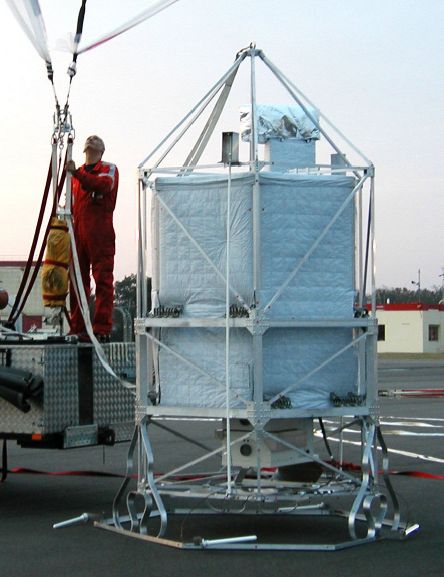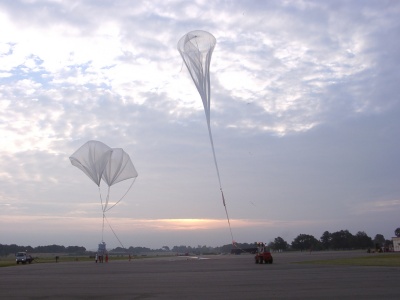Purpose of the flight and payload description
Is a spectrometer with six tunable diode lasers dedicated to in situ measurements of trace compounds in the upper troposphere and the stratosphere up to 35 km altitude.
The 6 laser beams circulate in a multipass HERRIOTT cell located below the gondola. The lower mirror of the two-mirror cell is fixed at the top of a deployable mast. The distance between mirror is about 3.50 m. Given the curvature of the two identical mirrors, two stable optical configuration can be used : first 86 reflections and 300 m optical path, second 156 reflections and 554 m optical path, by moving the lower mirror 5 mm up.
The mast is deployed during the flight to have the first measurements at the tropopause. Around the instrument, a rigid metal frame encompasses it, in order to have a instrument-safe landing.
Inside the instrument, three liquid nitrogen cryostats, hold the six diode lasers and the 12 detectors.
Vertical profiles of concentrations of a great number of species like O3, CH4, CO, CO2, N2O, HNO3, NO2, NO, HCl, HOCl, H2O2, and COF2, are measured with a very high vertical resolution, a high sensitivity and a high precision.
Details of the balloon flight
Balloon launched on: 10/2/2002
Launch site: Centre de Lancement de Ballons CLBA, Aire Sur L'Adour, Landes, France
Balloon launched by: Centre National d'Etudes Spatiales (CNES)
Balloon manufacturer/size/composition: Zero Pressure Balloon model 150z Zodiac - 150.000 m3
End of flight (L for landing time, W for last contact, otherwise termination time): 10/2/2001
Campaign: ENVISAT
The balloon was launched in the morning of October 2th, 2002 by dynamic method with the help of an auxiliary balloon.
No additional data is available.
During this flight several in-situ measurements (both in ascent and descent) were acomplished measuring the species : CO, O3, CO2, HCl, N2O, CH4, COF2, HOCl, H2O2, NO, H2O, NO2 and HNO3. These measurements were destinated to validate three instruments located onboard the ENVISAT satellite. The day of flight was choosed to allow ENVISAT close overpass of the balloon path, but it matched poorly with SCHIAMACHY, fairly well with MIPAS and none with GOMOS (due to the daytime).
External references
- SPIRALE website Laboratoire de Physique et Chimie de l'Environnement - Orleans
- ENVISAT validation with SPIRALE from 2002 autumn mid-latitude and 2003 winter arctic flights 16th ESA Symposium on European Rocket and Balloon Programmes and Related Research
- MIPAS Ozone Validation by Stratospheric Balloon and Aircraft Measurements 2nd Workshop on the Atmospheric Chemistry Validation of ENVISAT, 2004
- Overview of SCIAMACHY validation: 2002-2004 Atmos. Chem. Phys., 6, 127-148, 2006
- SPIRALE Experiment / Preliminary results of the Balloon Flight : 02 Oct. 2002 Envisat Validation Workshop 9-13 December 2002 ESRIN, Frascati, Italy
- Technical Note: Validation of Odin/SMR limb observations of ozone, comparisons with OSIRIS, POAM III, ground-based and balloon-borne instruments Atmos. Chem. Phys., 8, 3385-3409, 2008
- The Validation of the Envisat Chemistry Instruments by Use of Stratospheric Balloons and Aircraft ENVISAT Validation Workshop (ESA SP-531). 9-13 December, Frascati, Italy
- Validation of MIPAS CH4 Profiles by Stratospheric Balloon, Aircraft, Satellite and Ground Based Measurements 2nd Workshop on the Atmospheric Chemistry Validation of ENVISAT, 2004
- Validation of MIPAS N2O Profiles by Stratospheric Balloon, Aircraft and Ground Based Measurements 2nd Workshop on the Atmospheric Chemistry Validation of ENVISAT, 2004
- Validation of MIPAS-ENVISAT Version 4.61 HNO3 Operational Data by Stratospheric Balloon, Aircraft and Ground-Based Measurements 2nd Workshop on the Atmospheric Chemistry Validation of ENVISAT, 2004
- Validation of MIPAS-ENVISAT Version 4.61 Operational Data: NO2 2nd. Workshop on the Atmospheric Chemistry Validation of ENVISAT, 2004
172If you consider this website interesting or useful, you can help me to keep it up and running with a small donation to cover the operational costs. Just the equivalent of the price of a cup of coffee helps a lot.



